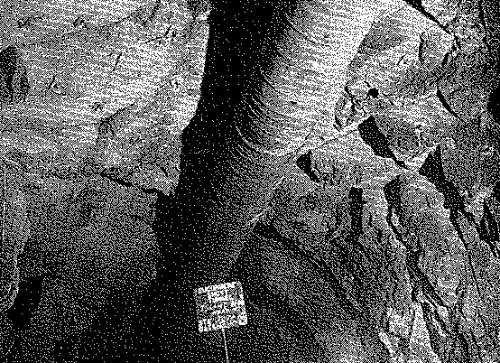UNSTABLE ROCK AND ITS TREATMENT SNOWY MOUNTAINS SCHEME
Systematic rock boltng over large areas is applicable to mainly hard rock which is extensively jointed and loosened due to the opening of joints (Fig. 13). It may contain narrow sheared and crushed zones with some clay, and it is usually wet. Such rock breaks under the action of explosives entirely to existing joint faces rather than by forming fresh fractures across joint blocks. Joint blocks tend to fall from the roof and walls.

Fig.13.—Extensively jointed hard granite, with partly open joints. Supported by a full pattern of grouted rock bolts, 8 ft long at 4ft centres. In the roof of Eucumbene-Snowy Tunnel.
Rock bolting is also applicable to zones of loosely jointed rock which often occurs marginally along isolated crushed zones and clayey seams up to several feet in width intersecting hard rock.
However steel rib supports are applicable where the rock is extensively jointed and most of the joints are clay coated, or where there are many clay seams over wide areas, or wide fault zones containing crushed rock and clay, or wide zones of decomposed rock.
In the worst areas, encountered over distances of some hundreds of feet in several tunnels, full face tunelling had to be suspended and the face advanced by a combination of soft-ground methods including forepoling or spiling driven ahead of the face, face boards, and crown and wall-plate drifts (Fig. 14). In some places side pressure on the ribs required the use of invert struts. Running ground rarely occurred and was overcome by the use of spiling face boards and close lagging.
Use of pneumatically applied mortar in final treatment
In unlined sections of tunnel weak areas other than those reinforced with grouted rock bolts are examined individually and in detail and given final treatment suited to its particular characteristics. This involves the use of pneumatically applied mortar, plain and reinforced, and grouted rock bolts, either alone or in various combinations (Figs. 15 and 16). The following are some examples.
Seams of clay and clayey crushed rock. Narrow seams of clay and crushed rock containing much clay are usually stable while the tunnel is being driven and they are exposed only to air. However when continuously exposed to water after the tunnel is in operation the exposed surface layer of the clay absorbs water, loses strength and then flows or is washed out of the seam. An open fissure thus develops which may extend progressively back into the rock mass. The effect of this process depends not only on the seam and on its orientation to the tunnel, but also on the nature of the rock which it intersects.
